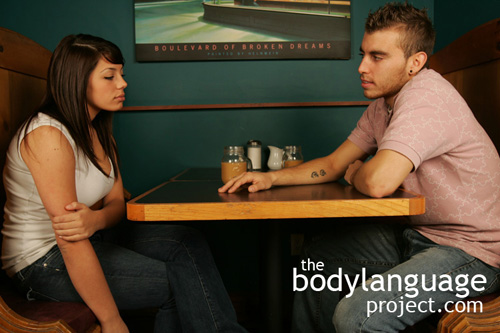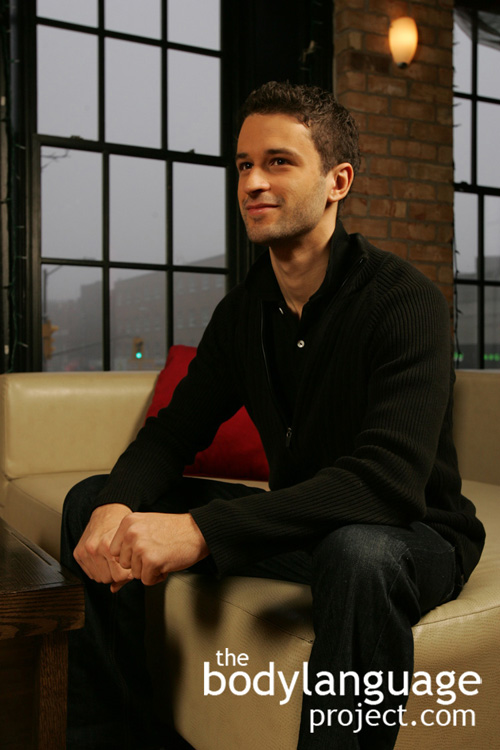As we know nervousness plays a big part in lie detection so we habitually connect the two sentiments. Therefore, by this nature, we assume that any of the following could be associated with dishonesty. Here is a nearly comprehensive list of all cues that could be tied to lying or else associated with lying from the general public. While they don’t necessarily uncover a liar they will be tied to dishonesty and persons that perform these cues will be mistrusted. They include increased eye blink rate, stuttering, dilated pupils, fidgeting, appearing unfriendly or tense, facial fidgeting, shaking, postural shifts or unrelaxed/reserved postures, twitches, shrugs, head movements, playing with objects, sneering, scowling, frowning, smiling, biting the lower lip, pressing the lips together, wrinkling of the nose, increase in perspiration, blushing or turning pale and increased swallowing.
Tag Archive for Dishonesty
Eye Patterns In Lying
by Chris Site Author • March 6, 2013 • 0 Comments

Eyes that wont make contact or seem to dart around as if they are fabricating stories can give liars away.
Shifty eyes, where the eyes dart all over the room to focus on anything but someone else’s eyes, is habitually associated with lying. However, as we learned previously, most practiced liars hold gaze even more strongly than in normal situations. In a study that looked at seventy-five countries, it was found that avoidance of eye contact was named as a lying trait in every single one of them. It is also frequently named first as a tell, and was named by old and young people alike. This trend exists cross culturally, despite any supportive scientific findings. People will stereotype liars as having shifty posture, self touching, appear nervous, have broken speech and so forth, but it is the belief that “they can’t look you in the eye” that is first and foremost on the tongue of all human lie detectors throughout the world! I suppose it would be less fascinating if that trait actually did predict lying, but it doesn’t. It’s simply a widespread belief that is passed down from generation to generation.
With regards to the general public who hold strong ideas about what a liar looks like, be sure to avoid gaze avoidance! Looking away for long periods of time, especially while talking, shifty eyes as mentioned, or using “stammering eyes”, which is the action of keeping the eyes closed for prolonged periods of time have all been noted as giving liars away. Despite widespread beliefs about how liars refuse to look other people in the eye, there is little empirical evidence to suggest its truth. Gaze avoidance might be more closely associated with the intent of appearing more subordinate, or to reduce anxiety and intensity so as to diffuse the situation.
Shutting out the outside world with stammering eyes can be a strong turn-off to other people, as can eye gaze avoidance which is probably why people universally attribute bad eye language to dishonesty. Negative impressions can stem from poor eye contact, even coming from the most honest and trustworthy people especially when it is the desire of others to label someone a liar for their own interest or purpose. It is a well known fact that when people hold specific beliefs they discount information that disproves their ideas, and actively seek out information that support it, some of which doesn’t exist in ready made form. To the more astute, it will come as obvious that reading bad eye language can help us reduce the creation of false impressions about others. Just because someone has unusual eye patterns does not mean that a person is lying, but chances are good that if you use bad eye language, or see someone else use bad eye language, you and they will be classified as untrustworthy.
The final aspect related to eye language worth mentioning is pupil dilation. Under stress or arousal of any kind, the pupils expand so as to allow more light in. This can include stress and fear due to lying, or any other fearful situations for that matter, but does not discount the stimulus of seeing something particularly attractive, as this too causes pupil dilation. By placing a suspect in the hot seat it is possible to gauge what level of fear he has with regards to accusations because it eliminates the confusion that outside stimulus creates larger pupils. However, like all lying language, pupil dilation is due to stress, which can result from being put in the hot seat! It is the gauging of pupil size from baseline that tells us something useful. Talking about something neutral like what they did last week on a random day, then switching to something more questionable like whether or not the stole office supplies is a great way to measure pupil differences as well as other lying language.
While we expect a liar to be more stressful overall, this isn’t always the case as has been one of the reoccurring themes in this chapter. However, if we wish to fool others, or maintain our innocence in their eyes, we should try to remain relaxed thereby giving off few or no negative cues.
Neck Scratch And Collar Pull
by Chris Site Author • March 6, 2013 • 0 Comments
When someone utters words such as “I completely agree with you, that sentiment is bang-on” but then punctuates the sentence with a neck scratch, it might mean that they in fact believe the opposite. Scratching the neck when no itch is present is a way to displace some of the nervous energy created by the lie and so distracts them from the pain of their dishonesty. Usually, the neck is scratched about five times, usually exactly. It seldom happens more than this, and rarely less. The collar pull is another form of self touching that is related to the neck. In this case, the idea is to reduce friction causes by an increase in blood flow to the neck. When stress increases, our face and necks flush with blood and we pull our collar away as an unconscious indication of this process. As blood flow increases to our neck, it stimulates nerves which in turn cause irritation and discomfort. Other times, the collar pull is a way to release heat created by our bodies while under pressure and discomfort from a neck that has become moist due to sweating.
Touch Reduction
by Chris Site Author • March 6, 2013 • 0 Comments
Touch reduction is usually accompanied with stressful questions or when information is presented that creates anxiety. Closeness can also be useful when assessing someone because it will invoke distancing desires. When talking with a spouse or child, sit as close as that which you are accustomed to before taking up serious matters. If someone is hiding something, they will usually push away or even stand up looking for ways to exit or change the subject. Holding the hand of a child can be particularly useful when discussing matters of dishonesty. If they wish to exit the discussion, they will try to tug their hand away.
Fist And Arms Clenched
by Chris Site Author • March 6, 2013 • 0 Comments
Holding the fists clenched and holding a full arm cross shows hostility, defensiveness and also readiness to attack. It can also be accompanied by a red face, clenched teeth, lowered eyebrows, a forward thrust of the lips or an angry expression. These accompanying signals show that physical aggression is imminent and likely, and ignoring them can be a huge mistake. Part of the reason we have aggression signals at all is to avoid risky physical confrontations. Our minds are hardwired to avoid possibly deadly or damaging situations. The signals are our way to warn others, or be warned by others, that we are nearing our threshold. All people are capable of lashing out with force if provided with the proper stimulus, any mother will agree.
In business and other context were violence is strictly forbidden we see an abbreviation of the hostile cues listed above. Here we see a more subtly form with the fists clenched tightly and the arms folded across the chest, usually while seated. Other times the dominant hand will make a fist with the other hand clasping the wrist. This is a mental way for the person to figuratively ‘hold themselves back.’ When we lack the right to express ourselves to our satisfaction, we hold back our negativity. Social norms and customs prevent us from expressing our true emotions whenever we desire.
Fist clenching happens very naturally and subconsciously; a slip of the hand so to speak. Women can even be seen doing this while being verbally berated by a partner. President Nixon was videotaped intensely balling his fist such that his knuckles turned white during a press conference called to discuss what was supposed to be a temporary incursion into Cambodia. The rest of his body was confident and his voice was smooth, yet his hands gave his restraint and dishonesty away. Of course, holding a tight fist does not necessarily mean they intent to strike out, rather it shows just the opposite – that their minds are dealing with a dilemma, of which social norms prevent physical resolutions. So very rarely are we allowed to fully express our emotions. In fact, one of the most important lessons we learn early in life is self control and this is exactly what happens when the fist is balled, clenched, but resists striking. We learn very early on that it’s not acceptable to throw fits and tantrums so we do the next best thing – we get very close to striking, but stop at the last second.
Whenever you are privy to clenching body language your first inclination should be to diffusing the situation. You might start by slowing down speech or stopping it altogether to allow the situation to simmer rather than continue boiling. You should then use open body language with palm up gestures to show honesty. Next, add submissive postures, head down, shoulders slumped and a reduction in body size. Your goal is to show that you are not interested in confrontation. You might even consider succeeding to their point of view, even just temporarily to allow them to take a saner headspace. In many cases it will be impossible to recover from this position successfully depending on what level of negativity is present. It’s always best to reduce tension early on before it gets out of control.
Sudden Changes In The Hands
by Chris Site Author • March 5, 2013 • 0 Comments
Hands can show real-time changes in an attitude. Imagine a couple sitting enjoying a romantic meal at a restaurant, with their hands bridging the gap between them as they sit facing one another hand-in-hand. The topic of conversation flows freely, but suddenly switches to a contentious issue, what would you imagine would happen to their hands? When there is disagreement between people, the hands are pulling inward and away from those we disagree with. This sort of behaviour can happen suddenly especially on a heated topic, but can also happen over time on issues that gradually show differences. When total disagreement is present, the body will even be withdrawn where the hands will rest on the lap. Taking the example of the couple above once again, imagine that only one of the two experiences a change in thought to the topic, their hands might remain outstretched in the center of the table and turn palm up as if to offer the idea to their partner as if to try to change their mind. Gradually the other might re-advance to join their hands once again or move them to their lap. As the argument fails, both parties hands might graduate away. If disagreement continues, feet might orient toward the door followed by torsos than finally their heads.

Arms are withdrawn when disagreement is high. These arms are busy protecting the torso in a single arm closed body posture – an ‘incomplete hug.’
Arms withdraw for a number of reasons but our subconscious mind tunes into our flight response and pulls hands in when we fear they will be hurt, and especially when they are hurt. When we touch a hot stove or hear a loud bang, our arms draw quickly into our bodies to protect them. This happens instantly with no ability to stop it. Likewise, our hands come in when we are worried or threatened despite a lack of physical threat. When our arms come in, our minds feel that they can block attacks better even when they are emotional in nature. Hands can be withdrawn for any number of reasons, not just disagreement, such as dishonesty. Honest hands are palm up, offering something to another person, or palm down in a confident authoritative position, but when hands are pulled away, they signal hidden thoughts of disagreement and lack of connectivity.
Hands can also suddenly change in terms of use of illustrators and seem to pause, stop or slow in their rate of use. Sudden cessation of gesticulation can indicate a freeze response due to being caught in a lie especially when the context warrants it. This is part of the flight or flight response as liars are trying to seem less noticeable. They are “hiding in plain sight” and to do this it is necessary to move less as movement attracts attention. Reducing expressiveness means fewer “tells” or so the lying mind thinks. When hands that are usually busy while talking according to a baseline, suddenly begin to slow, or become less expressive, it can signal a lack of enthusiasm or confidence for the topic. Whatever happens to the hands, when they suddenly change, we know that something internal has changed and it is usually tied directly to whatever is happening in the moment.
The Origins Of The Smile And The Honest Smile
by Chris Site Author • March 5, 2013 • 0 Comments

The orbicularis muscles
contract to form wrinkles in the corners of the eyes called crows feet – “smiling eyes”. When we see crows feet, we have true happiness.
Smiles are controlled by two sets of muscles which are the zygomatic major muscles, that run down the side of the face to connect to the corners of the mouth, and the orbicularis oculi muscles that pull the eyes back. The orbicularis muscles are particularly important as they are used to cause what’s called “smiling eyes”. Smiling eyes, also called “crow’s feet”, where a classic wrinkling appears in the corner of the eyes is an indication of true happiness. The zygomatic muscles, on the other hand, are consciously controlled and are the ones that normally flex when we smile for the camera. Therefore, the appearance of crow’s feet is a great way of determining genuine enjoyment. Insincere smiles appear as exposed teeth and stretched lips across the face with no wrinkles in the eyes. Crow’s feet however, can be faked with extreme smiles when the full face ends up really squished, but what separates the two is that in the real smile the corner of the eyes will turn downwards and the eyebrows will dip as well. The honest smile has also been called the “Duchenne smile”, after the French researcher Guillaume Duchenne who was first to research smiles using electrodiagnostics and electrical stimulation to distinguish between real and fake smiles.
Symmetry is also important in a real smile. Natural smilers will have more even smiles as both sides of their brain respond to pleasure. Smiles that are not genuine are more pronounced on the left side of the face since they are consciously being controlled. Interestingly uneven shoulder shrugs are also dishonest. Shoulder shrugs indicate when someone doesn’t know something, and if they are being truthful, their shoulders will come up in unison and sharply, however, if just one shoulder comes up and only slightly then they are following their statement with uncertainty. In other words, dishonesty shows through when the body language to support an emotion lacks full symmetry and follow through. Shoulder shrugs is a “gravity defying” body language, meaning it requires energy and commitment, so it should happen emphatically and completely for it to have its full honest value otherwise it is just feigned serving only to appease. When you see weak smiles or shoulders that only partially come up then you know that someone is trying to be misleading about their true thoughts and feelings.
Liars also find it difficult to smile, instead preferring a straight face, but when they do smile, it appears forced and especially strained showing their underlying stress. Smiling is a subconsciously submissive gesture and liars often worry about being caught so they feel that smiling might give them away. Therefore instead of appearing natural to the person they are lying to, they instead tense up and try to appear expressionless instead. Smiling can therefore be an effective way to come across as honest, although smiling too big, for too long or at inappropriate times will have the reverse effect.
Regardless, fake smiles are difficult to distinguish from real smiles and only experts and those reading this book will know what to look for! That’s why smiling, even if phony, can be effective in influencing other’s thoughts, emotions and opinions of you so in reality it doesn’t hurt to smile often. If you smile big, and frequently, those around you might just wonder about what sort of pleasant things are happening in your life and want some of those good things to rub off on them!
Congruence
by Chris Site Author • March 5, 2013 • 0 Comments
The word congruence, as it relates to body language, refers to the degree to which body language cues in a person matches one another in terms of their meaning. If, for example, one is speaking honestly with the palms up (an honest gesture) we can say that the body language and verbal language are congruent. That is, honest words match up with honest body language. A child with their hands in their pockets (dishonest gesture) speaking about how they didn’t steal a cookie is incongruent since their body language does not match their verbal language.
We regularly place more importance on what words are used rather than how others gestures in their delivery, but this is a mistake. When we don’t have congruency and the verbal language doesn’t match the nonverbal gestures we should always place more importance on the nonverbal channel. Credence should almost always be given to nonverbal language over spoken words since the research tells us that it is often more accurate. When people plan lies they often rehearse the sentences and in what sequence they will deliver them, but they often ignore or disregard gestures that will accompany them. While we monitor our spoken words, our unconsciousness can leak unwanted information through our bodies. However, even if people were consciously aware that their body language gave them away, they would not know what to do since most people are completely unaware of the meaning their body conveys.
Politicians can leak information through congruency and this can give them away, although most politicians today are quite learned in body language. We should be suspicious of politicians, however, when they have their arms tightly folded against their chest while saying that they are open to change or to a door-to-door salesman that swears his life on a product but wipes downward with his hand as if to clear the lie. Another example is the cheating husband who tries to pass off a late meeting and then pulls at his neck tie, collar or scratch his neck indicating stress.
Sometimes however, knowledge about body language just comes off as less expressiveness. The body language thus tends to be much more controlled and subdued because it’s much easier to eliminate body language altogether then it is to add honest body language. However, even reduced expressiveness helps us read people because a relaxed and natural politician is more likely to be telling the truth. Therefore, even reserved body language can be a ‘tell’ to those who are in tune. Congruency therefore, is very important because it is a clear comparison between two communication channels, the verbal and nonverbal. When words are mismatched against the body language, we can be sure something dishonest is at play and these hints should instigate us, at minimum, to pay closer attention.








